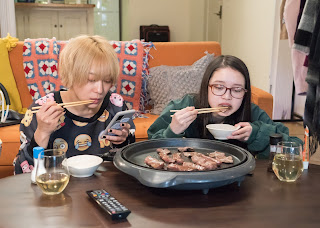Text © Richard
Gary / Indie Horror Films, 2022
Images from
the Internet, unless indicated
Baby Assassins
(aka Beibî
warukyûre)
Directed by Yugo Sakamoto
Rights Cube; Far East Films;
Well Go USA Entertainment; Hi-Yah!
95 minutes, 2021 / 2022
www.wellgousa.com/films/baby-assassins
@WellGoUSA
When I first read the title, I was confused: was this about infants in diapers who kill people, or adults who kill toddlers? Of course, in both cases, I was wrong (pretty sure I would be). I should have known better as this film is from Japan.
The “babies” in question are two teenage high school girls and possibly future cosplay objects, Chisato (Akari Takahasi). and blonde Mahiro (Saori Izawa). They are the innocents who are both about to graduate from assassin school, and are highly trained to kill. Needless to say, there are some strong comic elements to the story as they butt heads.
The film is on a couple of different tiers: first, there is the stereotypical two opposites needing to work together to survive with fun and merriment, and then there are the (literally) deadly serious assassinations, where the ladies come into their own. Like many teenagers, even with their killing expertise, it’s the simple and every day tasks that are filled with angst (such as adding whip cream to a meal).
Like “The Odd Couple” (whatever incarnation), their personalities are different, and yet they overlap in Zinn Diagram means. For example, Mahiro is Gen Whatever, with a slacker attitude of not-caring or wanting to be bothered, whose wardrobe choice is PJ bottoms and a tee (at one point it’s a Lou Reed Transformers one); and yet, she has an inclination towards philosophy. Chisato, on the other hand, is more focused, but just as lost in menial tasks. Thing with Assassin School is that, as implied, they teach killing but not social skills needed for employment or fitting into society. This is a really interesting added on touch.
Reminiscent of the series “Dead Like Me” (2003-04), between assignments the women are expected to hold down jobs that will not bring much attention to them. For example, Chisato, at some point, works in a small waffle eatery as wait- and kitchen staff, but is totally out of her element.
Now, 20 minutes into the film, and we are somewhat familiar with their sitch, enter the credits and a flashback to them first being thrust together. The commentary on government bureaucracy, such as taxes, housing and basically not taking care of their own (sound familiar?) permeates the underscore of the film. This is used both as comedy fodder and with a figuratively pointed stick.
Another jab of the elbow in the side is the Japanese tendency for older men to be attractive to younger women, as I mentioned previously. Be it an assassination target or a store clerk, the two are hit on mostly by adult men. Creepy; always was, always will be.
Things get a bit darker in the third act, as our heroines are at odds over attitudes, and to add to the mix is confrontations with a Yakuza (must be powerful; he has all of his fingers), his blowhard son Kazuki (think Sonny Corleone), and revenge seeking, psychotic, over-the-top enthusiastic daughter, Himari, who seems to be about the same age as our two killin’ protagonists.
In the first two acts, there are some decent kills scattered throughout, and somewhere along the way I made a note for myself, “Increased violence in the third act?” Of course there is, including one superb fight with Izawa, who has some Taekwondo training, and a Yakuza. Now, the fight scenes are not overly choreographed to ridiculous level, with people flying through the air, or stylized like the infamous corridor scene in the original Oldboy (2003). This is sloppy in a good way, more like fighting than something sterile in a mainstream release.
I also really liked this dive into modern Japanese culture. In fact, there are two things discussed that I had to look up: the first was a food called Oden, which is a fish cake stew (ironically, I was eating fishcakes while I was watching this… ”it’s a small world, but I wouldn’t want to paint it” – Steven Wright. But I digress…). The conversation about it takes on almost a Tarantino-eque quality, without the camera needing to swirl around the couch. The other is the use of the expression Moe Moe Kyun, which apparently means something like happiness to a level of blushing.
The director does really well in translating the personality of our two assassins to be likeable characters, even when they misbehave. He also has a way of showing the mixture of action and the lull between without getting boring. It is a mash-up of the mundane and murderous mayhem. Sometimes the action comes as a surprise, which was quite pleasant, and other times, it builds up. Also, pleasant.
By the end, it kind of leaves it off as a possible franchise, as the Japanese are wont to do with police procedurals and gangster mayhem. If this comes to be true, I will enjoy seeing what happens next with Mahiro and Chisato.
The film is available on the martial arts streaming service Hi-Yah!, and the digital and Blu-ray versions will be accessible on August 16, 2022.
IMBD Listing HERE




No comments:
Post a Comment